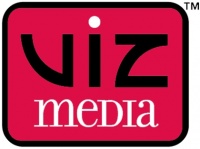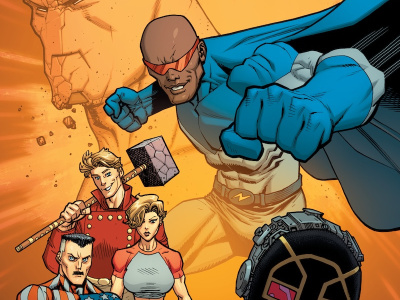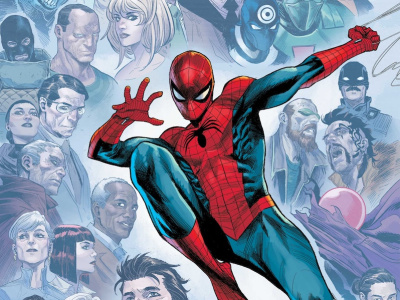
Once again this year ICv2 had a chance to sit down with Viz Media Senior Vice President and General Manager Alvin Lu at the San Diego Comic-Con to discuss current conditions in the manga market and Viz Media’s plans for the future. In Part II of the interview Lu discusses the various digital platforms that Viz utilizes, the potential effects of Day & Date releases, and what Viz Media learned from its experiences with anime that could be applied to the world of digital publishing. In Part I of the interview Lu talks about the effects of Borders’ demise on manga publishers and the current state of the market (see “The ICv2 Interview: Alvin Lu, Pt.1”)
Digital is the area of largest change for Viz over the past year. You’ve gone from having no manga available for purchase digitally to having products available on multiple platforms. Can you talk about where you are on having manga available on all these different platforms?
We launched Vizmanga.com at Comic-Con. It completes a stage that we wanted to get to in terms of the digital buildout. When we started it was important to us to get the apps out. At the time, the iPad was the optimal device in terms of the display for the material. At the same time we knew that having a Website was important principally as a hub. You still need a place as an entry point and a Website’s a natural place to do that. At the same time, for people who don’t have mobile devices that we’re currently on, the Website still provides an optimal environment for reading manga. It allows us to really broaden our reach. That was a principal stone to place and now that we have the foundation with the apps on the Website to build off of.
How many volumes do you have available digitally?
I think we’re around the 300 range right now.
And how are you trending? How many new offerings per week or month?
At this point we were on a schedule of adding 10 new titles per week—a lot of back catalog. It’s been getting the catalog up there. We’re starting discussion on how we want to approach is [as the] back catalog gets filled out.
Is all the material available digitally also available in print? Is there any thought to having titles available digitally that are not available in print?
Yes. Obviously the possibility to do that exists. I can’t really go into specifically some of the decisions that we’re mulling over, but yes, there are certain titles that we’re looking at to do digitally, without, right away anyway, a print component.
What’s your current windowing strategy in terms of when you put out titles digitally vs. in print? How do you see that issue?
Right now we’re not seeing a lot of cannibalization, partly just because it’s more backlist right now. That’s become a nice incremental layer of sales on top of our normal backlist sales. If you look at the backlist POS sales and you start to add digital on top, you [see] incremental sales. You don’t see any cannibalization of backlist print sales. Once you move to day and date with new releases, it could be a different story. We did a couple of experiments and nothing particularly conclusive came out of it. We’re als o in a different model than the comic shops. We experimented with Bakuman 4 and we didn’t see any impact on the printed sales. On the other hand, we have more of a book publishing model than a periodical publishing model. It may be that you don’t really have the strict laydown dates with the books, so it’s something we’ll probably continue to experiment with. As of right now we’re still looking at front list as being primarily driven by the print business.
Viz is in an unique position since you’ve been through the digitization process before in another medium in anime. Can you discuss any lessons from anime and apply them to this current situation with manga?
It’s been actually really helpful to have that experience under our belt. Publishing and animation are obviously different businesses. Viz has been strategizing in both for a long time. The experience and the sense of confidence that we had built up in our digital animation business definitely helped us as we attempt to apply what we’ve learned to the manga business across the board. It helped temper our strategy, our expectations of how this would evolve, and in some ways things are evolving much the way it looked early on with the animation business, which was first slow and incremental and then began to build up quite rapidly.
So where are we on that curve with manga?
Still in the very early stages. There was a two to three year period where things were gradually ramping up. It wasn’t like flipping a switch overnight. At a certain point, within the third year, the revenues became quite significant to the point where they were supplanting revenues that had been lost before because of market forces.
Do you have any plans to go onto any of the book devices—Kindle, Nook, that kind of thing?
I’ll say right now that we’re definitely looking at it. What you’re seeing with all these different platforms, it’s not just different devices, it’s also a kind of business environment. The apps are a certain kind of business environment, the Web is another, and e-readers are another. It’s a pretty tall order to ask—we’re still primarily a traditional print publisher company and you’re realizing that each of these lines are a kind of a business specialization. What’s interesting is that we’ve been able to manage synergy across several different lines. The synergy management is something that we’re fairly good at doing, although you do have to develop some sort of specialization when it comes to the digital material, but then you realize that each channel has its specializations that need to be built out.
At our conference we had a discussion about where the market was going to be in two years at Comic-Con 2013. Can you talk about where you think the manga market’s going to be in 2013?
I think manga went through a down cycle and in two years we’re actually going to be back in an upcycle. I have a lot of long-term confidence in the medium. Manga is comics. I’m not one of those who draws hard lines between manga and comics. At the same time the way comics have evolved in Japan, there’s a different grammar to the form. I have a lot of belief in the power of that form that has come from there and actually in very interesting ways is spreading around the world inspiring new creators who are not Japanese. One of the things that came out of the last big manga wave was the development of non-Japanese creators inspired working within the manga grammar. That, actually in two years, we’re going to be seeing more of. I do think we’ll be seeing that sort of new generation I was referring to begin to grow again bringing us different kinds of energies and tastes so that we’ll be maybe seeing slightly different kinds of manga.
As far as the digital vs. first print discussion goes, I think the digital market share’s going to increase. I’m not one of those who thinks that print books are going to be supplanted by digital books. There is probably going to be point of equilibrium. Probably not in two years—that equilibrium will not have been reached yet, but we’re going to be at that point where digital’s going to be bigger than it is now but it’ll be a matter of where we all are now—delivering content throughout the multiple channels that we’re all in now only in a more mature form.
Last question—what are you most excited about editorially from Viz in the next six to 12 months?
To me the most exciting thing is seeing some of these newer titles continue to grow. When I say that, what we do is look at the volume over volume initials and you can see that they follow a very healthy pattern when they grow volume over volume. It means they’re picking up new fans and gaining momentum so they’re graduating to the next level and continuing to build up a fan following for those titles. There’s a number of titles that a re not as prominent on BookScan, but some of the shojo titles like Dengeki Daisy follow similar patterns and so these titles are ones that portend growth in our manga audience for the immediate future.
America has been waiting to see where the next hot new title will be coming from.
To go back to Part 1, click here.







